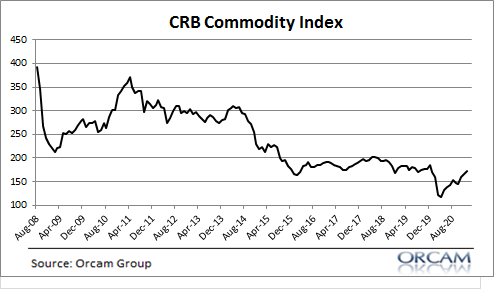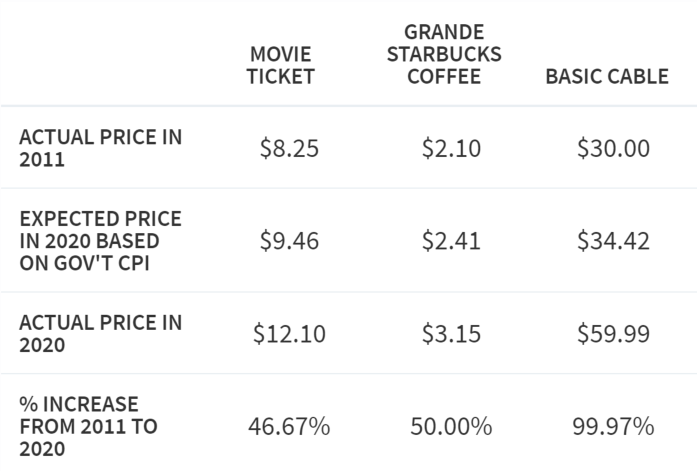One of the long running themes on this website is low inflation and debunking narratives about how very high inflation might be around the corner. I like to work from a first principles understanding, looking at things for what they are and trying to be as objective as possible. Overall, my predictions about low inflation and low interest rates over the last 10 years have been mostly spot-on. Sure, in the last year I’ve been predicting rising inflation due to the huge stimulus measures, but I want to keep that in perspective – when I say I expect higher inflation I am saying that I expect inflation to return to 2019 or higher levels and that the Fed could start to feel pressure to raise rates by 2022. That means 2-3% inflation and rising rates. It doesn’t mean a return to the 1970s or
Topics:
Cullen Roche considers the following as important: Most Recent Stories, Myth Busting
This could be interesting, too:
Cullen Roche writes Understanding the Modern Monetary System – Updated!
Cullen Roche writes We’re Moving!
Cullen Roche writes Has Housing Bottomed?
Cullen Roche writes The Economics of a United States Divorce
One of the long running themes on this website is low inflation and debunking narratives about how very high inflation might be around the corner. I like to work from a first principles understanding, looking at things for what they are and trying to be as objective as possible. Overall, my predictions about low inflation and low interest rates over the last 10 years have been mostly spot-on.
Sure, in the last year I’ve been predicting rising inflation due to the huge stimulus measures, but I want to keep that in perspective – when I say I expect higher inflation I am saying that I expect inflation to return to 2019 or higher levels and that the Fed could start to feel pressure to raise rates by 2022. That means 2-3% inflation and rising rates. It doesn’t mean a return to the 1970s or something like Zimbabwe.
Anyhow, there’s a narrative going around that inflation is 10% or more based on some index called the Chapwood Index (they actually claim a 9.9% average over 5 years in 50+ cities). It’s worth exploring because the cost of many items that feel essential (education, healthcare and real estate in particular) make it seem like inflation is higher than we’re being told. So let’s dig in.
1) Inflation of 10% is Inconsistent with Other Data.
The first item that makes this narrative difficult to believe is the idea that inflation has been so much higher than nominal GDP. Nominal GDP has averaged just 3.6% in the last 10 years. So, if inflation has been 10% or more for much of this period then that means our economy has shrunken by 50% since 2010 and 80% since 2000 in real terms.
Here’s how this looks vs reality. And bear in mind – this. Is. Absurd. On. Its. Face.

The main problem is that it is inconsistent with a ton of other verifiable data like wage growth, employment, corporate revenues, factory output, and on and on. To believe that the economy has been shrinking at a rate of 6%+ per year is simply unfathomable.
The alternative option there is that the government isn’t lying about inflation, but is instead lying about growth. In other words, maybe NGDP has been 12% on average? Except we run into the same problem with alternative data which shows that growth has actually been low.
2) Have the bond and commodity markets been wrong all this time?
The other thing that makes this narrative virtually impossible to believe is bond and commodity markets.¹ Commodity markets have been crushed for over 10 years. And bond yields have been in a perpetual decline. This is true across all bond markets around most of the world.²
So, if inflation has been 10% all this time then that would mean that some of the biggest and smartest markets in the world have had it all backwards. Anyone who is an enthusiast of free markets (as I am) would surely believe these large markets over anecdotal data, right?

3) The Items and Methodology Create Sampling Bias.
A more specific look at the Chapwood Index shows some potentially serious problems with sampling bias.
First, they choose 500 items claiming that the BLS CPI uses too many items. Okay, but some of these 500 items are flatly absurd:
- Ballet shoes
- Crossword puzzle book
- Blackberry service – is that even a thing?
Further, many of the items are so nondescript that it would be virtually impossible to accurately measure them over time.
The way this is being sampled from friends is also potentially problematic. The BLS uses regionally sourced surveys of thousands of people and items to provide regional and nationally location specific data. It’s an extremely thorough process. The Chapwood Index, on the other hand, appears anecdotal and, in many cases, flatly wrong. For instance, they provide actual data for some of the items they priced:

All three of these items are wrong!
IMDB, for instance, independently calculates the average price of a movie ticket. They found the price to be almost identical to the BLS figure.
Starbucks actually provides online pricing. I checked my local Encinitas store here in Southern California, which I would imagine is on the higher end of the national prices and a Grande Coffee is just $2.65, 20% lower than the stated price.
The price of “basic cable” is harder to calculate, but exposes the problem with an unadjusted tech service like cable. For instance, I pay $110 per month for premium internet. However, COX just increased my data package by 25% with the same price. So, I got 25% more of the product which equates to a lower cost per unit of good. People sometimes complain about hedonic adjustments in the BLS data, but this is precisely why we have them. Things get better over time and the BLS tries to adjust the data to quantify how prices alone don’t fully reflect the change in the cost of goods/services.
In sum, sure, the BLS is imperfect. And they might be understating inflation to some degree. But be skeptical when you hear these anecdotal narratives about sky high inflation.
¹ – Some people will inevitably scream about “asset inflation” in response to this. This isn’t a thing. Inflation specifically refers to consumer prices.³ Capital goods prices rise when our living standards rise. Consumer prices rising could reflect a decline in our living standards. For example, if I build a house with my bare hands from nothing (boring fact, I just did this!) and then sell this house for $1MM more than it cost me to build and real estate prices keep rising by 10% per year then you might scream about 10% “asset inflation”. But the buyer has a $1mm capital good appreciating at 10% and I have their $1mm. We are both better off. On the other hand, if I make a taco and sell it to you for 10% more than it cost me to make and the price of those tacos keeps rising 10% then you need to keep buying 10% more expensive tacos because you consumed the taco.
² – Some people will inevitably scream about how the Fed has “manipulated rates lower”. This misunderstands the Fed Funds market and the fact that a positive overnight rate is always manipulated UP from 0%. See myth #2 in my article on Common Myths About the Fed.
³ – A footnote in a footnote! I love when that happens. No, you silly Austrian econ advocates, inflation is not a rise in the money supply. Anyone who understands banking and endogenous money knows that the money supply is pretty much always rising because the population grows over time and the demand for loans and goods and services is always rising.
